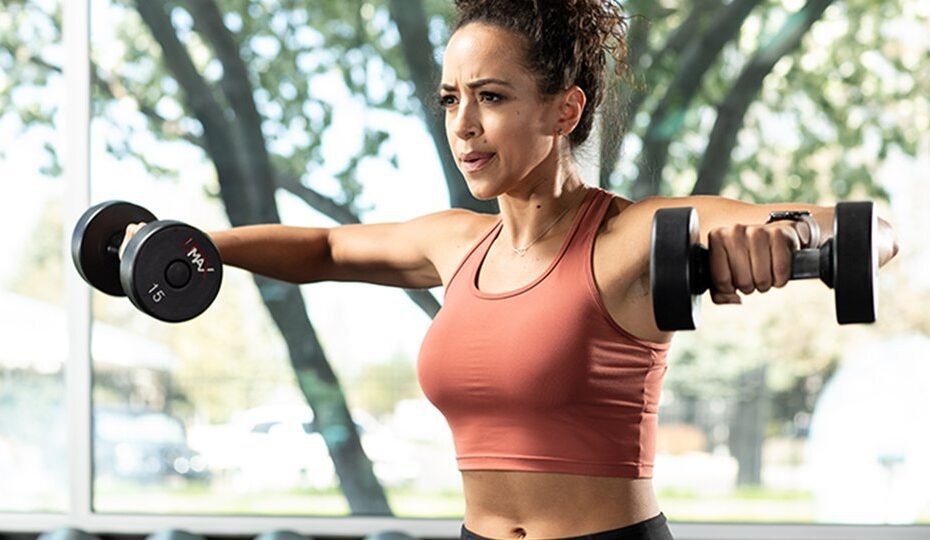The dumbbell lateral raise stands as a pivotal exercise for sculpting and strengthening the lateral deltoid, enhancing shoulder aesthetics and overall upper body symmetry. In this comprehensive guide, we delve into how to perform the exercise correctly, the array of benefits it provides, essential safety tips, alternative exercises, and versatile variations to infuse innovation into your shoulder training regimen.
Muscle Worked:
The dumbbell lateral raise primarily targets the following muscles:
- Primary Muscle: Lateral Deltoid (Lateral Head of Deltoid)
- Secondary Muscles: Anterior Deltoid, Supraspinatus, Trapezius
How to Do Dumbbell Lateral Raise:
Mastering the proper technique for the dumbbell lateral raise is crucial for optimal results and avoiding strain. Follow these step-by-step instructions:

- Setup: Stand with feet shoulder-width apart, knees slightly bent. Grasp a dumbbell in each hand, palms facing the body, and let them hang by your sides.
- Starting Position: Maintain a slight bend in your elbows and engage your core muscles.
- Raising: Exhale as you lift the dumbbells to the sides, maintaining a slight bend in your elbows. Elevate the dumbbells until they are parallel to the ground.
- Peak Contraction: Pause briefly at the top of the movement, feeling the contraction in your lateral deltoids.
- Lowering: Inhale as you lower the dumbbells back to the starting position in a controlled manner.
- Repeat: Perform the desired number of repetitions, focusing on controlled motion and proper form.
Benefits:
Explore the myriad advantages that the dumbbell lateral raise offers to your shoulder and upper body development:
- Lateral Deltoid Emphasis: The primary focus on the lateral deltoid contributes to a well-rounded and sculpted shoulder appearance.
- Shoulder Aesthetics: This exercise enhances the width of your shoulders, creating a visually appealing V-taper.
- Shoulder Stability: Engaging the supraspinatus muscles aids in enhancing shoulder joint stability.
- Improved Posture: Strengthening the lateral deltoids contributes to overall upper body posture improvement.
- Functional Strength: The lateral raise mimics motions involved in lifting objects out to the sides, translating to functional strength.
- Injury Prevention: Developing the lateral deltoid helps in preventing imbalances that may lead to shoulder injuries.
Safety Tips:
While performing the dumbbell lateral raise, keep these safety tips in mind:
- Use a weight that allows you to maintain proper form and control throughout the movement.
- Avoid using momentum to lift the weights; focus on controlled muscle engagement.
- Perform the exercise with a gradual and controlled tempo to prevent jerking or swinging.
- Keep a slight bend in your elbows throughout the movement to reduce stress on the joint.
- If you experience pain or discomfort, stop the exercise and consult a fitness professional or healthcare provider.
Alternative Exercises:
Broaden your shoulder training with these alternative exercises, each offering unique benefits:
- Bent-Over Dumbbell Lateral Raise: Leaning forward focuses the engagement on the rear deltoids.
- Front Raise: Lifting the dumbbells to the front emphasizes the anterior deltoids.
- Upright Row: Incorporates the traps while targeting the lateral deltoids.
- Face Pull: Engages the rear deltoids and promotes healthy shoulder mobility.
- Cable Lateral Raise: Utilizes cable resistance for continuous tension throughout the movement.
Variations:
Infuse innovation into your routine with these versatile variations:
- Lateral Raise Drop Set: Perform a set to failure, then immediately reduce the weight and continue for added intensity.
- Lateral Raise with Isometric Hold: Pause for a few seconds at the top of each repetition for increased time under tension.
- Lateral Raise with Bands: Incorporate resistance bands for accommodating resistance and a different feel.
- Lateral Raise Machine: Utilize a lateral raise machine for a controlled and isolated movement.
- Lateral Raise on Incline Bench: Perform the lateral raise on an incline bench for a unique angle of stimulation.
Incorporating the dumbbell lateral raise and its variations can lead to pronounced lateral deltoid development, improved shoulder aesthetics, and enhanced upper body strength. Prioritize proper form, gradual weight progression, and individualized training to suit your fitness level and objectives. If you have pre-existing shoulder issues or concerns, seeking guidance from fitness professionals or healthcare providers is recommended before incorporating these exercises.
